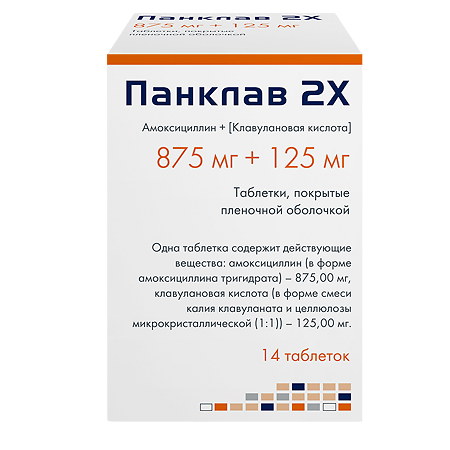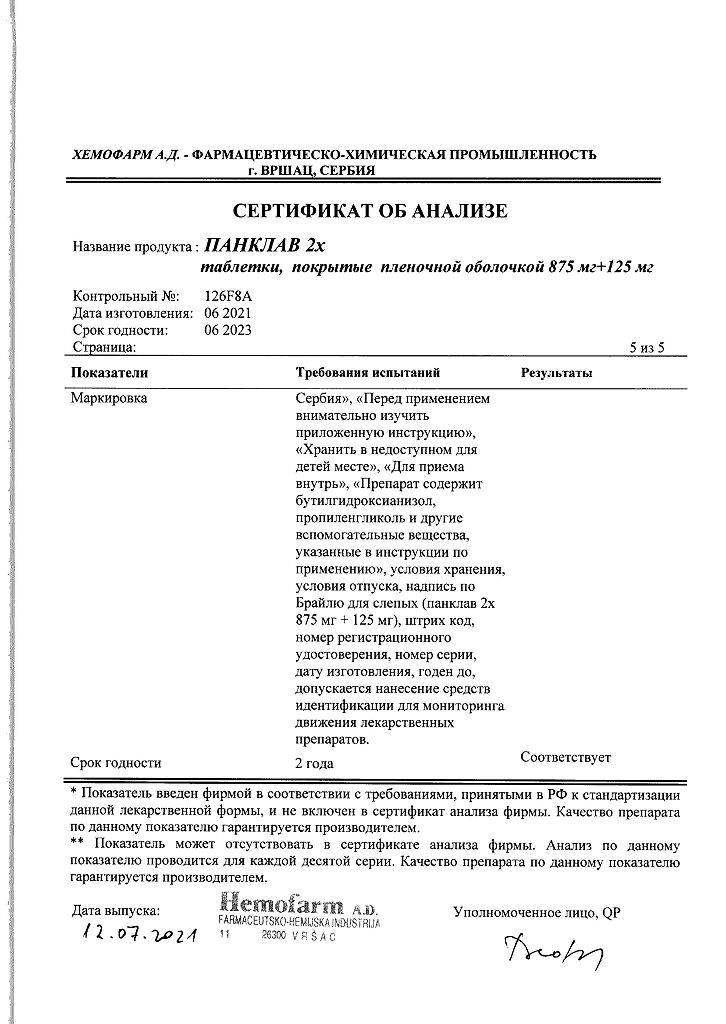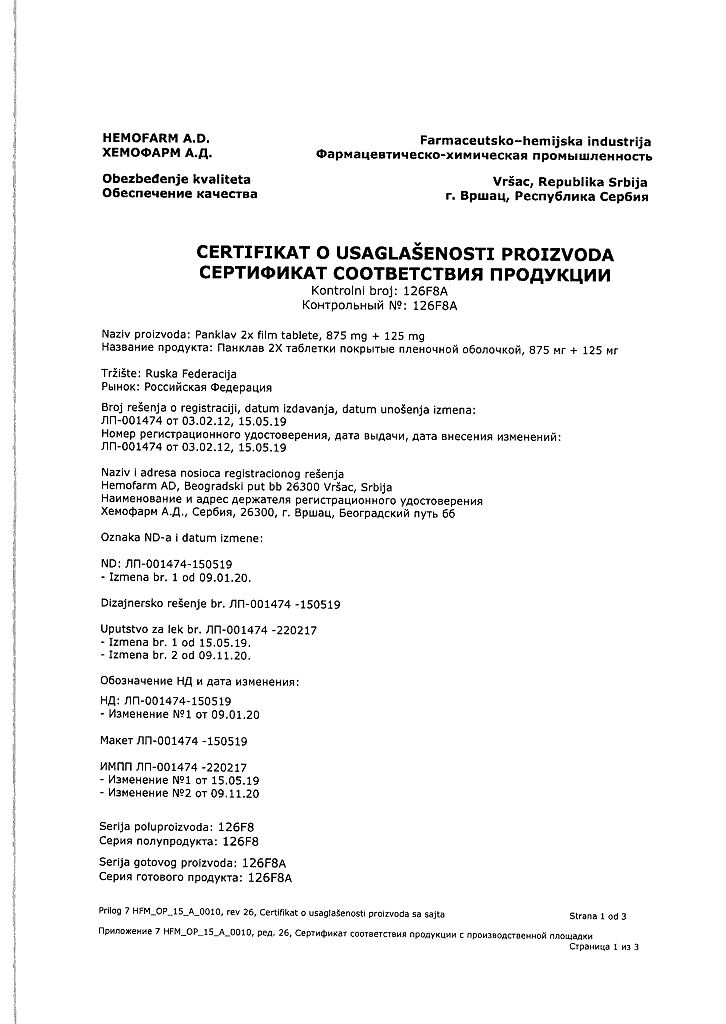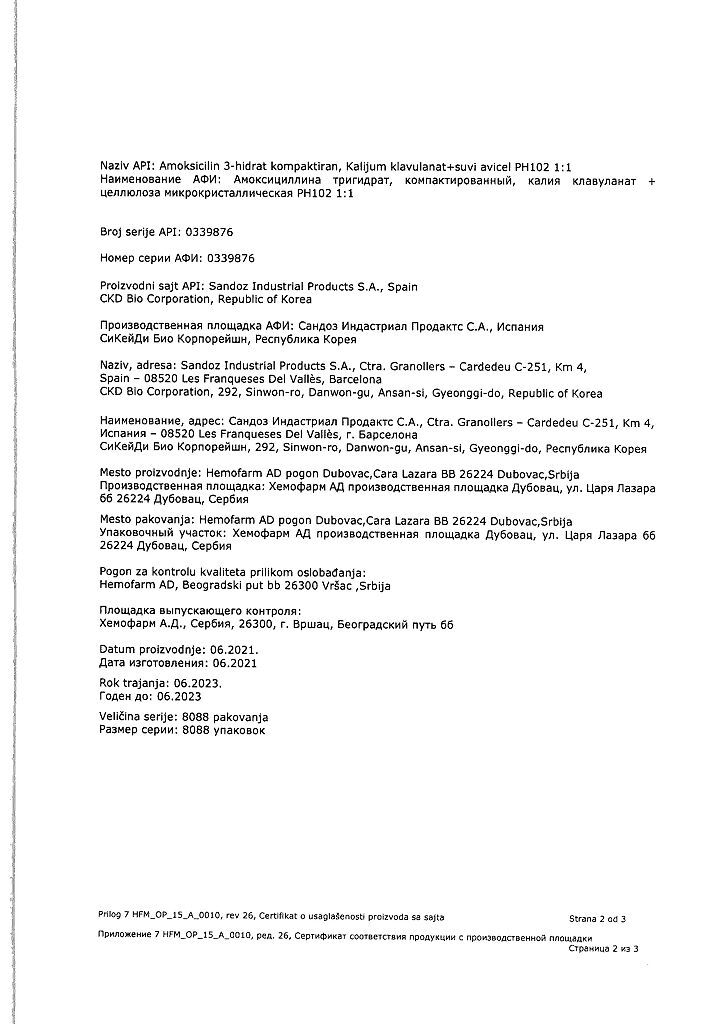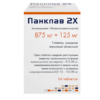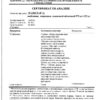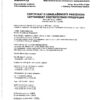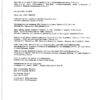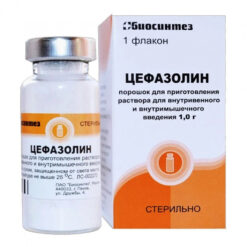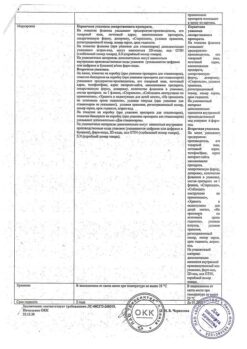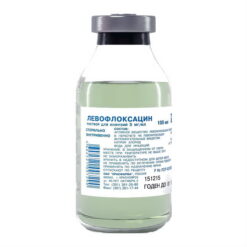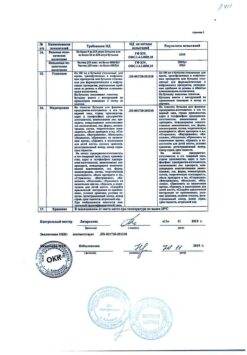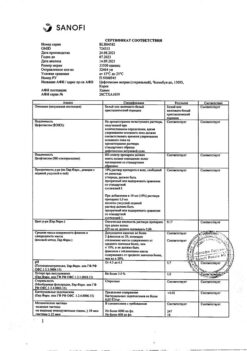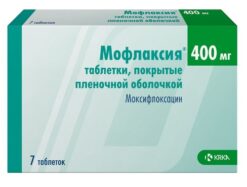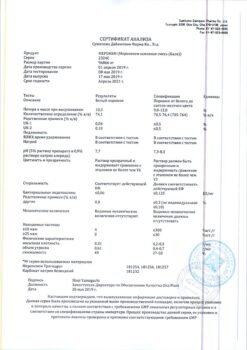No products in the cart.
Panklav 2X, 875 mg+125 mg 14 pcs
€1.00
Out of stock
(E-mail when Stock is available)
Description
Periodontitis, Urinary tract infections, Osteomyelitis, Otitis media, Guillotine, cholecystitis, Angina, Lung inflammation (pneumonia), Skin infections, Pharyngitis, Tonsillitis, Bronchitis
To reduce the development of drug-resistant bacteria and to maintain the effectiveness of the combination of amoxicillin + clavulanic acid and other antibacterial drugs, the combination should be used only to treat infections for which sensitive bacteria are proven or reasonably suspected to cause them. When culture and sensitivity information is available, it should be considered when selecting or modifying antibiotic therapy. In the absence of such data, the local epidemiologic situation and sensitivity patterns may contribute to the empirical choice of therapy.
The combination amoxicillin + clavulanic acid is indicated for the treatment of infections caused by susceptible strains of the indicated bacteria for the conditions listed below (according to rxlist.com, 2020).
Lower respiratory tract infections caused by beta-lactamase-producing strains of Haemophilus influenzae and Moraxella catarrhalis.
Acute bacterial otitis media caused by strains of H. influenzae and M. catarrhalis producing beta-lactamase.
Sinusitis caused by strains of H. influenzae and M. catarrhalis producing beta-lactamase.
Infections of the skin and its appendages caused by strains of Staphylococcus aureus, Escherichia coli and Klebsiella species producing beta-lactamase.
Infections of the genitourinary tract caused by strains of E. coli, Klebsiella species and Enterobacter species producing beta-lactamase.
Limitations of use
When sensitivity test results show sensitivity to amoxicillin, indicating no beta-lactamase production, the combination amoxicillin + clavulanic acid should not be used.
Indications
Indications
To reduce the development of drug-resistant bacteria and maintain the effectiveness of amoxicillin + clavulanic acid and other antibacterial drugs, the combination should be used only to treat infections that are proven or reasonably suspected to be caused by susceptible bacteria. When culture and susceptibility information is available, it should be considered when selecting or changing antibiotic therapy. In the absence of such data, local epidemiology and susceptibility patterns may guide empirical selection of therapy.
The combination of amoxicillin + clavulanic acid is indicated for the treatment of infections caused by sensitive strains of these bacteria in the conditions listed below (according to rxlist.com, 2020).
Lower respiratory tract infections caused by beta-lactamase-producing strains of Haemophilus influenzae and Moraxella catarrhalis.
Acute bacterial otitis media caused by beta-lactamase-producing strains of H. influenzae and M. catarrhalis.
Sinusitis caused by beta-lactamase-producing strains of H. influenzae and M. catarrhalis.
Infections of the skin and its appendages caused by strains of Staphylococcus aureus, Escherichia coli and Klebsiella species that produce beta-lactamase.
Infections of the genitourinary tract caused by strains of E. coli, Klebsiella species and Enterobacter species producing beta-lactamase.
Limitations of Use
When sensitivity test results show sensitivity to amoxicillin, indicating absence of beta-lactamase production, the amoxicillin + clavulanic acid combination should not be used.
Pharmacological effect
Pharmacological effect
Pharmacological group
Penicillins in combinations
Special instructions
Special instructions
Hypersensitivity reactions
Serious and sometimes fatal hypersensitivity reactions (anaphylactic) have been reported in patients receiving beta-lactam antibacterial drugs, including the combination of amoxicillin + clavulanic acid. These reactions occur more often in people with a history of penicillin hypersensitivity and/or a history of sensitivity to multiple allergens. Before starting therapy with a combination of amoxicillin + clavulanic acid, you should carefully study information about previous hypersensitivity reactions to penicillins, cephalosporins or other allergens. If an allergic reaction occurs, the combination of amoxicillin + clavulanic acid should be discontinued and appropriate therapy should be prescribed.
Liver dysfunction
Liver dysfunction, including hepatitis and cholestatic jaundice, has been associated with the use of amoxicillin + clavulanic acid. Liver toxicity is usually reversible; however, deaths have been reported. In patients with liver failure, liver function should be regularly monitored.
Diarrhea associated with Clostridium difficile
Clostridium difficile-associated diarrhea has been reported with virtually all antibacterial agents, including amoxicillin + clavulanic acid, and can range in severity from mild diarrhea to fatal colitis. Treatment with antibacterial agents leads to modification of the normal flora of the large intestine and excessive growth of C. difficile.
Strains of C. difficile produce toxins A and B, which cause diarrhea. Hypertoxin-producing strains of C. difficile result in increased risk of morbidity and mortality as these infections may be resistant to antimicrobial therapy and require colectomy. The possibility of C. difficile-associated diarrhea should be considered in all patients who complain of diarrhea after using antibacterial agents. A thorough history taking is necessary, because the development of C. difficile-associated diarrhea is possible within two months after the use of antibacterial drugs.
If C. difficile-associated diarrhea is suspected or confirmed, non-C. difficile antibacterial agents may need to be discontinued. Appropriate fluid and electrolyte monitoring, protein supplementation, antibacterial treatment for C. difficile-associated diarrhea, and surgical exploration are necessary if clinically indicated.
Skin rash in patients with mononucleosis
A large percentage of patients with mononucleosis treated with amoxicillin develop an erythematous skin rash. Therefore, the combination of amoxicillin + clavulanic acid should not be prescribed to patients with mononucleosis.
Possibility of microbial overgrowth
During therapy, the possibility of developing fungal or bacterial superinfections should be considered. If superinfection occurs, the combination of amoxicillin + clavulanic acid should be discontinued and appropriate therapy should be instituted.
Development of resistant bacteria
It is unlikely that prescribing amoxicillin + clavulanic acid in the absence of a proven or reasonably suspected bacterial infection will benefit the patient and will not increase the risk of developing drug-resistant bacteria.
Use in pediatrics
The safety and effectiveness of amoxicillin + clavulanic acid powder for oral suspension have been established in pediatric patients. The use of amoxicillin + clavulanic acid in pediatric patients is supported by data from a study of amoxicillin + clavulanic acid film-coated tablets in adults, with additional data from a study of amoxicillin + clavulanic acid powder for oral suspension in pediatric patients aged 2 months to 12 years with acute otitis media (see Clinical Studies).
Due to incompletely developed renal function in neonates and infants, the elimination of amoxicillin may be delayed; clavulanate excretion was unchanged in this age group. The dose of the amoxicillin + clavulanic acid combination should be adjusted in pediatric patients < 12 weeks (< 3 months) of age.
Application in geriatrics
Of the 3119 patients in the analysis of the results of clinical trials of the combination of amoxicillin + clavulanic acid, 32% were aged ≥65 years, 14% were aged ≥75 years. No overall differences in safety or effectiveness were observed between these subjects and younger subjects, and other reported clinical experience has not shown differences in responses between older and younger patients, but greater sensitivity in some older subjects cannot be excluded.
This drug is known to be largely eliminated by the kidneys, and the risk of adverse reactions may be higher in patients with impaired renal function. Because elderly patients are more likely to have decreased renal function, caution should be exercised in dose selection and monitoring of renal function may be helpful.
Renal dysfunction
Amoxicillin is primarily eliminated by the kidneys and dose adjustments are usually required in patients with severe renal impairment (GFR < 30 mL/min).
Active ingredient
Active ingredient
Amoxicillin, Clavulanic acid
Composition
Composition
Active ingredients:
Amoxicillin (in the form of amoxicillin trihydrate) – 875 mg.,
Clavulanic acid (in the form of a mixture of potassium clavulanate and microcrystalline cellulose (1:1)) – 125 mg.,
Excipients:
Microcrystalline cellulose – 510.35 mg,
Sodium carboxymethyl starch (type A) – 32.8 mg,
Magnesium stearate – 32 mg,
Colloidal silicon dioxide anhydrous – 24 mg,
Butylated hydroxyanisole – 0.85 mg.
Film casing:
Hypromellose – 34.84 mg,
Titanium dioxide (E171) – 17.42 mg,
Propylene glycol – 8.17 mg,
Talc – 3.57 mg.
Pregnancy
Pregnancy
Pregnancy
FDA category of effect on the fetus is B.
Teratogenic effects. Reproduction studies conducted in pregnant rats and mice treated with the combination of amoxicillin + clavulanic acid (2:1 amoxicillin:clavulanate) at oral doses up to 1200 mg/kg/day did not reveal any evidence of fetal harm from the combination. Doses of amoxicillin for rats and mice (based on body surface area) were approximately 4 and 2 times the adult MRDV when administered orally (875 mg every 12 hours).
For clavulanate, these multiples were approximately 9 and 4 times the adult MRDV for oral administration (125 mg every 8 hours). However, there are no adequate and well-controlled studies in pregnant women. Because animal reproduction studies are not always predictive of effect in humans, this combination should be used during pregnancy only when absolutely necessary.
Labor and delivery
Oral ampicillin class of antibiotics is poorly absorbed during labor. It is unknown whether the use of amoxicillin + clavulanic acid in women during labor has immediate or delayed adverse effects on the fetus, increases the duration of labor, or increases the likelihood of the need for obstetric intervention.
Breast-feeding
Amoxicillin has been shown to be excreted into a woman’s breast milk. The use of the combination of amoxicillin + clavulanic acid by nursing mothers may lead to sensitization of infants. Caution should be exercised when using the combination in a nursing woman.
Contraindications
Contraindications
Serious hypersensitivity reactions. The combination of amoxicillin + clavulanic acid is contraindicated in patients with a history of serious hypersensitivity reactions (eg, anaphylaxis or Stevens-Johnson syndrome) to amoxicillin, clavulanate, or other beta-lactam antibacterial drugs (eg, penicillins and cephalosporins).
Cholestatic jaundice/liver dysfunction. The combination of amoxicillin + clavulanic acid is contraindicated in patients with a history of cholestatic jaundice/liver dysfunction associated with the combination.
Side Effects
Side Effects
The following side effects are described in more detail in the Precautions section.
Anaphylactic reactions (see “Precautions”);
Hepatic dysfunction (see “Precautions”);
Clostridium difficile-associated diarrhea (see “Precautions”).
Clinical trial experience
Because clinical trials are conducted under a different set of conditions, the incidence of adverse reactions observed in these clinical trials may not be the same as those obtained in other clinical trials and observed in clinical practice.
The most common adverse reactions were diarrhea/loose stools (9%), nausea (3%), skin rash and urticaria (3%), vomiting (1%) and vaginitis (1%). Less than 3% of patients discontinued therapy due to drug-associated adverse reactions. The overall incidence of adverse reactions, particularly diarrhea, increased with higher recommended doses. Other less common adverse reactions (<1%) include abdominal discomfort, flatulence and headache.
In pediatric patients (aged 2 months to 12 years), 1 clinical trial was conducted in the United States/Canada comparing amoxicillin + clavulanic acid at a dose of 45/6.4 mg/kg/day (divided every 12 hours) for 10 days and 40/10 mg/kg/day (divided every 8 hours) for 10 days in the treatment of acute otitis media. A total of 575 patients were included and only the suspension was used in this study. In general, the observed adverse reactions were comparable to those noted above; however, there were differences in the incidence of diarrhea, skin rash/urticaria, and diaper rash (see Clinical Studies).
Post-marketing experience
In addition to the adverse reactions reported during clinical trials, the following were observed during postmarketing use of the amoxicillin + clavulanic acid combination. Because reports of these cases are voluntary, from a population of uncertain size, it is not always possible to reliably estimate their frequency. These cases were selected for inclusion based on a combination of their severity, frequency of reporting, or possible causal relationship to amoxicillin + clavulanic acid.
Gastrointestinal tract
Dyspepsia, gastritis, stomatitis, glossitis, black “hairy” tongue, mucocutaneous candidiasis, enterocolitis and hemorrhagic/pseudomembranous colitis. Symptoms of pseudomembranous colitis may appear during or after treatment with antibiotics (see Precautions).
Hypersensitivity reactions
Pruritus, angioedema, serum sickness-like reactions (urticaria or skin rash accompanied by arthritis, arthralgia, myalgia and often fever), erythema multiforme, Stevens-Johnson syndrome, acute generalized exanthematous pustulosis, hypersensitivity vasculitis, and cases of exfoliative dermatitis (including toxic epidermal necrolysis) (see “Precautions”).
Liver
Hepatic dysfunction, including hepatitis and cholestatic jaundice, increased levels of serum transaminases (AST and/or ALT), serum bilirubin and/or alkaline phosphatase have been reported when taking the combination of amoxicillin + clavulanic acid. These adverse reactions have been reported more often in the elderly, in men, or in patients undergoing long-term treatment. Histologic findings from liver biopsy were consistent with predominantly cholestatic, hepatocellular, or mixed cholestatic hepatocellular changes. Signs/symptoms of liver dysfunction may appear within or several weeks after discontinuation of therapy. Liver dysfunction, which can be severe, is usually reversible. Deaths have been reported (see Contraindications, Precautions).
Renal
Interstitial nephritis, hematuria and crystalluria have been reported (see Overdose).
Blood and lymphatic system
Anemia, including hemolytic anemia, thrombocytopenia, thrombocytopenic purpura, eosinophilia, leukopenia and agranulocytosis, has been reported. These reactions are usually reversible after discontinuation of therapy and are considered to be manifestations of hypersensitivity. Thrombocytosis was observed in less than 1% of patients using the combination of amoxicillin + clavulanic acid. An increase in PT has been reported in patients receiving concomitant amoxicillin + clavulanic acid and anticoagulant therapy (see Interactions).
CNS
Agitation, anxiety, behavioral changes, confusion, seizures, dizziness, insomnia, and reversible hyperactivity have been reported.
Miscellaneous
Discoloration of teeth (brown, yellow, or gray) has been reported. Most reports were in pediatric patients. In most cases, the discoloration was reduced or eliminated with toothbrush or brushing.
Interaction
Interaction
Probenecid
Probenecid reduces the secretion of amoxicillin by the renal tubules, but does not delay the excretion of clavulanic acid through the kidneys. Simultaneous use with a combination of amoxicillin + clavulanic acid can lead to an increase in the concentration and prolonged presence of amoxicillin in the blood. Concomitant use of probenecid is not recommended.
Oral anticoagulants
Abnormally prolonged PT (elevated INR) has been reported in patients receiving amoxicillin and oral anticoagulants. When anticoagulants are co-administered with the combination of amoxicillin + clavulanic acid, appropriate monitoring should be carried out. Dosage adjustments of oral anticoagulants may be necessary to maintain the desired level of anticoagulation.
Allopurinol
Concomitant use of allopurinol and amoxicillin increases the incidence of rash in patients receiving both drugs compared to patients receiving amoxicillin only. It is unknown whether this increase in rash with amoxicillin is due to allopurinol or the hyperuricemia present in these patients.
Oral contraceptives
The combination of amoxicillin + clavulanic acid may affect intestinal flora, leading to decreased estrogen reabsorption and decreased effectiveness of combined oral contraceptives containing estrogen/progesterone.
Effect on laboratory tests
High concentrations of amoxicillin in urine may cause false-positive results when testing for urine glucose using the CLINITEST® test, Benedict’s solution, or Fehling’s solution. Because this effect may also occur with amoxicillin + clavulanic acid, it is recommended to use glucose tests based on glucose oxidase enzyme reactions.
When amoxicillin was used by pregnant women, a temporary decrease in the concentration of total conjugated estriol, estriol glucuronide, conjugated estrone and estradiol in plasma was noted.
Overdose
Overdose
In case of overdose, it is necessary to stop taking the drug, carry out symptomatic treatment and, if necessary, take supportive measures. A prospective study of 51 pediatric patients at a poison control center found that amoxicillin overdose of less than 250 mg/kg was not associated with significant clinical symptoms4.
Cases of interstitial nephritis leading to oliguric renal failure have been reported in patients after overdose of the amoxicillin + clavulanic acid combination.
Crystalluria, in some cases leading to renal failure, has also been observed after overdose of the amoxicillin + clavulanic acid combination in adults and children. In case of overdose, adequate fluid intake and diuresis should be maintained to reduce the risk of crystalluria. Apparently, renal failure is reversible after stopping the drug. High blood levels may occur more frequently in patients with impaired renal function due to decreased renal clearance of the amoxicillin + clavulanic acid combination. The combination of amoxicillin + clavulanic acid can be removed from the bloodstream using hemodialysis.
Storage conditions
Storage conditions
Store at a temperature not exceeding 30°C in the original packaging.
Keep out of the reach of children.
Shelf life
Shelf life
2 years.
Do not use after the expiration date stated on the package.
Manufacturer
Manufacturer
Hemofarm A.D., Serbia
Additional information
| Shelf life | 2 years. Do not use after the expiration date printed on the package. |
|---|---|
| Conditions of storage | Store at a temperature not exceeding 30oC in the original package. Keep out of reach of children. |
| Manufacturer | Chemopharm A.D., Serbia |
| Medication form | pills |
| Brand | Chemopharm A.D. |
Related products
Buy Panklav 2X, 875 mg+125 mg 14 pcs with delivery to USA, UK, Europe and over 120 other countries.

